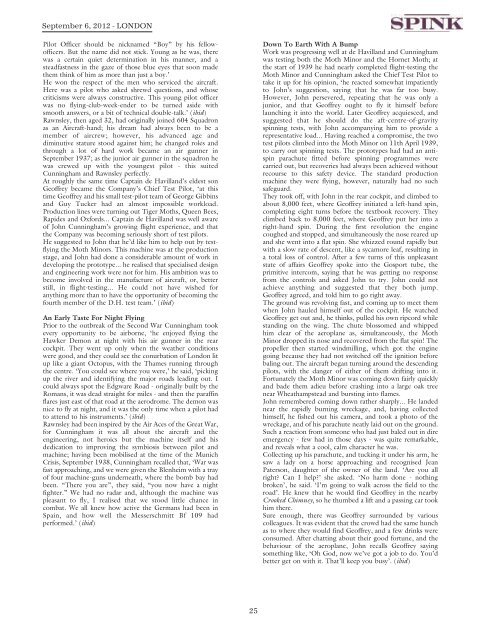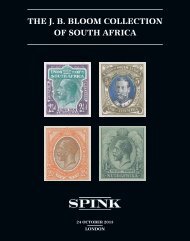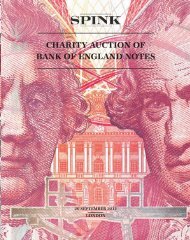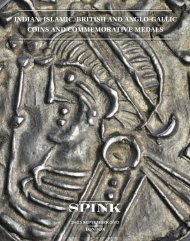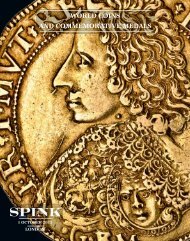bentley priory - Spink
bentley priory - Spink
bentley priory - Spink
You also want an ePaper? Increase the reach of your titles
YUMPU automatically turns print PDFs into web optimized ePapers that Google loves.
September 6, 2012 - LONDON<br />
Pilot Officer should be nicknamed “Boy” by his fellowofficers.<br />
But the name did not stick. Young as he was, there<br />
was a certain quiet determination in his manner, and a<br />
steadfastness in the gaze of those blue eyes that soon made<br />
them think of him as more than just a boy.’<br />
He won the respect of the men who serviced the aircraft.<br />
Here was a pilot who asked shrewd questions, and whose<br />
criticisms were always constructive. This young pilot officer<br />
was no flying-club-week-ender to be turned aside with<br />
smooth answers, or a bit of technical double-talk.’ (ibid)<br />
Rawnsley, then aged 32, had originally joined 604 Squadron<br />
as an Aircraft-hand; his dream had always been to be a<br />
member of aircrew; however, his advanced age and<br />
diminutive stature stood against him; he changed roles and<br />
through a lot of hard work became an air gunner in<br />
September 1937; as the junior air gunner in the squadron he<br />
was crewed up with the youngest pilot - this suited<br />
Cunningham and Rawnsley perfectly.<br />
At roughly the same time Captain de Havilland’s eldest son<br />
Geoffrey became the Company’s Chief Test Pilot, ‘at this<br />
time Geoffrey and his small test-pilot team of George Gibbins<br />
and Guy Tucker had an almost impossible workload.<br />
Production lines were turning out Tiger Moths, Queen Bees,<br />
Rapides and Oxfords... Captain de Havilland was well aware<br />
of John Cunningham’s growing flight experience, and that<br />
the Company was becoming seriously short of test pilots.<br />
He suggested to John that he’d like him to help out by testflying<br />
the Moth Minors. This machine was at the production<br />
stage, and John had done a considerable amount of work in<br />
developing the prototype... he realised that specialised design<br />
and engineering work were not for him. His ambition was to<br />
become involved in the manufacture of aircraft, or, better<br />
still, in flight-testing... He could not have wished for<br />
anything more than to have the opportunity of becoming the<br />
fourth member of the D.H. test team.’ (ibid)<br />
An Early Taste For Night Flying<br />
Prior to the outbreak of the Second War Cunningham took<br />
every opportunity to be airborne, ‘he enjoyed flying the<br />
Hawker Demon at night with his air gunner in the rear<br />
cockpit. They went up only when the weather conditions<br />
were good, and they could see the conurbation of London lit<br />
up like a giant Octopus, with the Thames running through<br />
the centre. ‘You could see where you were,’ he said, ‘picking<br />
up the river and identifying the major roads leading out. I<br />
could always spot the Edgware Road - originally built by the<br />
Romans, it was dead straight for miles - and then the paraffin<br />
flares just east of that road at the aerodrome. The demon was<br />
nice to fly at night, and it was the only time when a pilot had<br />
to attend to his instruments.’ (ibid)<br />
Rawnsley had been inspired by the Air Aces of the Great War,<br />
for Cunningham it was all about the aircraft and the<br />
engineering, not heroics but the machine itself and his<br />
dedication to improving the symbiosis between pilot and<br />
machine; having been mobilised at the time of the Munich<br />
Crisis, September 1938, Cunningham recalled that, ‘War was<br />
fast approaching, and we were given the Blenheim with a tray<br />
of four machine-guns underneath, where the bomb bay had<br />
been. “There you are”, they said, “you now have a night<br />
fighter.” We had no radar and, although the machine was<br />
pleasant to fly, I realised that we stood little chance in<br />
combat. We all knew how active the Germans had been in<br />
Spain, and how well the Messerschmitt Bf 109 had<br />
performed.’ (ibid)<br />
Down To Earth With A Bump<br />
Work was progressing well at de Havilland and Cunningham<br />
was testing both the Moth Minor and the Hornet Moth; at<br />
the start of 1939 he had nearly completed flight-testing the<br />
Moth Minor and Cunningham asked the Chief Test Pilot to<br />
take it up for his opinion, ‘he reacted somewhat impatiently<br />
to John’s suggestion, saying that he was far too busy.<br />
However, John persevered, repeating that he was only a<br />
junior, and that Geoffrey ought to fly it himself before<br />
launching it into the world. Later Geoffrey acquiesced, and<br />
suggested that he should do the aft-centre-of-gravity<br />
spinning tests, with John accompanying him to provide a<br />
representative load... Having reached a compromise, the two<br />
test pilots climbed into the Moth Minor on 11th April 1939,<br />
to carry out spinning tests. The prototypes had had an antispin<br />
parachute fitted before spinning programmes were<br />
carried out, but recoveries had always been achieved without<br />
recourse to this safety device. The standard production<br />
machine they were flying, however, naturally had no such<br />
safeguard.<br />
They took off, with John in the rear cockpit, and climbed to<br />
about 8,000 feet, where Geoffrey initiated a left-hand spin,<br />
completing eight turns before the textbook recovery. They<br />
climbed back to 8,000 feet, where Geoffrey put her into a<br />
right-hand spin. During the first revolution the engine<br />
coughed and stopped, and simultaneously the nose reared up<br />
and she went into a flat spin. She whizzed round rapidly but<br />
with a slow rate of descent, like a sycamore leaf, resulting in<br />
a total loss of control. After a few turns of this unpleasant<br />
state of affairs Geoffrey spoke into the Gosport tube, the<br />
primitive intercom, saying that he was getting no response<br />
from the controls and asked John to try. John could not<br />
achieve anything and suggested that they both jump.<br />
Geoffrey agreed, and told him to go right away.<br />
The ground was revolving fast, and coming up to meet them<br />
when John hauled himself out of the cockpit. He watched<br />
Geoffrey get out and, he thinks, pulled his own ripcord while<br />
standing on the wing. The chute blossomed and whipped<br />
him clear of the aeroplane as, simultaneously, the Moth<br />
Minor dropped its nose and recovered from the flat spin! The<br />
propeller then started windmilling, which got the engine<br />
going because they had not switched off the ignition before<br />
baling out. The aircraft began turning around the descending<br />
pilots, with the danger of either of them drifting into it.<br />
Fortunately the Moth Minor was coming down fairly quickly<br />
and bade them adieu before crashing into a large oak tree<br />
near Wheathampstead and bursting into flames.<br />
John remembered coming down rather sharply... He landed<br />
near the rapidly burning wreckage, and, having collected<br />
himself, he fished out his camera, and took a photo of the<br />
wreckage, and of his parachute neatly laid out on the ground.<br />
Such a reaction from someone who had just baled out in dire<br />
emergency - few had in those days - was quite remarkable,<br />
and reveals what a cool, calm character he was.<br />
Collecting up his parachute, and tucking it under his arm, he<br />
saw a lady on a horse approaching and recognised Jean<br />
Paterson, daughter of the owner of the land. ‘Are you all<br />
right Can I help’ she asked. ‘No harm done - nothing<br />
broken’, he said. ‘I’m going to walk across the field to the<br />
road’. He knew that he would find Geoffrey in the nearby<br />
Crooked Chimney, so he thumbed a lift and a passing car took<br />
him there.<br />
Sure enough, there was Geoffrey surrounded by various<br />
colleagues. It was evident that the crowd had the same hunch<br />
as to where they would find Geoffrey, and a few drinks were<br />
consumed. After chatting about their good fortune, and the<br />
behaviour of the aeroplane, John recalls Geoffrey saying<br />
something like, ‘Oh God, now we’ve got a job to do. You’d<br />
better get on with it. That’ll keep you busy’. (ibid)<br />
25


